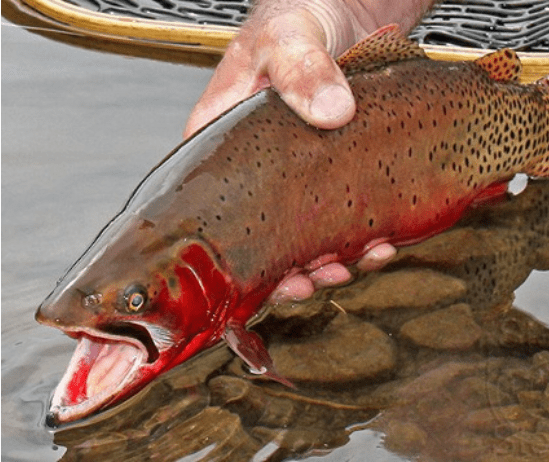Cutthroat Trout Information

Cutthroat Trout Species Facts
Cutthroat trout (Oncorhynchus clarkii) is a prized and iconic species native to North America's cold, clear waters. There are multiple species of cutthroat trout native to Colorado, which are an essential part of the state's diverse aquatic ecosystems, contributing to the allure of its lakes and rivers. The cutthroat trout has a rich history, with various subspecies inhabiting different regions. While Greenback and San Juan cutthroat are also native to Colorado, the Colorado River cutthroat trout (Oncorhynchus clarkii pleuriticus) is the most prominent species of cutthroat in the Centennial State. Historically, Colorado River cutthroat were widespread across the Colorado River Basin, and efforts are ongoing to restore its populations to their native habitats.
Cutthroat trout thrive in cold, pristine waters, making them well-suited for Colorado's mountainous landscapes. They prefer high-altitude streams, rivers, and lakes, where the water is clear and oxygen-rich. These habitats mimic their native environments, and efforts are made to conserve and protect these ecosystems to sustain healthy cutthroat trout populations. Cutthroat trout typically spawn in the spring, and their spawning rituals are crucial to maintaining their populations. During this time, the fish migrate to prime spawning grounds, usually shallow and fast-flowing sections of headwater streams or tributaries. The female creates a nest, known as a redd, by using her tail to clear gravel and debris. She then deposits her eggs in the redd, and the male fertilizes them. After spawning, both male and female cutthroat trout may guard the nest for a brief period. The size of cutthroat trout can vary based on habitat, available food, and genetics. They generally range from small, especially in headwater streams, to larger specimens in lakes and larger rivers. On average, Colorado River cutthroat trout grow to between 6 and 12 inches, although some individuals can exceed 20 inches. One distinctive feature of cutthroat trout is its vibrant coloration, especially during the spawning season. They often display a pinkish-red slash mark on each side of their throat, which gives them their name. The rest of their body exhibits a mix of olive, yellow, and red hues, providing excellent camouflage in their natural environment.
Fly Fishing for Cutthroat Trout
Cutthroat trout fishing is a popular pastime in Colorado, attracting anglers seeking a rewarding and challenging experience. Many rivers and lakes in the state offer opportunities to catch these prized fish, providing a mix of stunning scenery and excellent fishing. Anglers typically use various fly-fishing techniques, given the cutthroat trout's inclination towards insect-based diets. Dry flies, nymphs, and streamers resembling local insect life are commonly used to entice these elusive fish. Understanding the insect hatches and feeding patterns in specific waters can significantly improve the angler's success. Conservation initiatives are pivotal in ensuring the sustainability of cutthroat trout populations in Colorado. Efforts include habitat restoration, removing non-native species that threaten their ecosystems, and stocking hatchery-reared cutthroat trout to supplement wild populations. Catch-and-release practices are often encouraged to preserve the integrity of these fisheries. The cutthroat trout adds an invaluable dimension to Colorado's diverse aquatic ecosystems. Understanding the life cycle, habitat preferences, and conservation needs of cutthroat trout is essential for anglers and conservationists, ensuring that future generations can continue to enjoy the beauty and challenge of pursuing this iconic species in Colorado's pristine waters.
